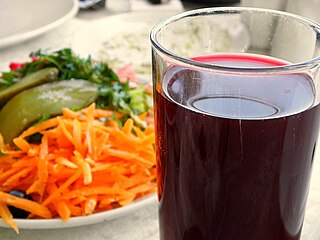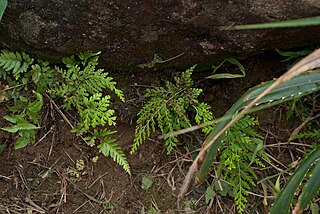Related Research Articles

Palm wine, known by several local names, is an alcoholic beverage created from the sap of various species of palm tree such as the palmyra, date palms, and coconut palms. It is known by various names in different regions and is common in various parts of Africa, the Caribbean, South America, South Asia, Southeast Asia and Micronesia.

Kombucha is a fermented, lightly effervescent, sweetened black tea drink commonly consumed for its purported health benefits. Sometimes the beverage is called kombucha tea to distinguish it from the culture of bacteria and yeast. Juice, spices, fruit or other flavorings are often added.

Nata de coco, also marketed as coconut gel, is a chewy, translucent, jelly-like food produced by the fermentation of coconut water, which gels through the production of microbial cellulose by Komagataeibacter xylinus.

Fermented fish is a traditional preservation of fish. Before refrigeration, canning and other modern preservation techniques became available, fermenting was an important preservation method. Fish rapidly spoils, or goes rotten, unless some method is applied to stop the bacteria that produce the spoilage. Fermentation is a method which attacks the ability of microbials to spoil fish. It does this by making the fish muscle more acidic; bacteria usually cease multiplying when the pH drops below 4.5.

Ayran, doogh, dhallë, daw, shaneena, xynogala or tan is a cold savory yogurt-based beverage of Turkic origin, popular across Central Asia, West Asia, Southeastern Europe, North Asia and Eastern Europe. The principal ingredients are yogurt, water and salt. Herbs such as mint may be optionally added. Some varieties are carbonated. Ayran is notably quite popular in Iran.

Tapai is a traditional fermented preparation of rice or other starchy foods, and is found throughout much of Southeast Asia, especially in Austronesian cultures, and parts of East Asia. It refers to both the alcoholic paste and the alcoholic beverage derived from it. It has a sweet or sour taste and can be eaten as is, as ingredients for traditional recipes, or fermented further to make rice wine. Tapai is traditionally made with white rice or glutinous rice, but can also be made from a variety of carbohydrate sources, including cassava and potatoes. Fermentation is performed by a variety of moulds including Aspergillus oryzae, Rhizopus oryzae, Amylomyces rouxii or Mucor species, and yeasts including Saccharomyces cerevisiae, and Saccharomycopsis fibuliger, Endomycopsis burtonii and others, along with bacteria.

Puto is a Filipino steamed rice cake, traditionally made from slightly fermented rice dough (galapong). It is eaten as is or as an accompaniment to a number of savoury dishes. Puto is also an umbrella term for various kinds of indigenous steamed cakes, including those made without rice. It is a sub-type of kakanin.
Lambanóg is a traditional Filipino distilled coconut palm liquor. It is derived from tubâ made from coconut sap that has been aged for at least 48 hours. It originates from Luzon and the Visayas Islands. During the Spanish colonial period, it was also known as vino de coco in Spanish. It is also commonly described as "coconut vodka" due to its clear to milky white color and high alcohol content. It is particularly potent, having a typical alcohol content of 80 to 90 proof after a single distillation; this may go as high as 166 proof after the second distillation.
Bahalina, sometimes called "coconut red wine", is a traditional Filipino palm wine made from fermented coconut or nipa palm sap. It is derived from tubâ that has been aged for several months to several years. It originates from the Visayas and Mindanao islands of the southern Philippines. It is deep brown-orange in color and has a slightly bitter astringent taste.

Şalgam or Şalgam Suyu, pronounced "shal-gam", is a popular Turkish traditional fermented beverage from the southern Turkish cities of Adana, Hatay, Tarsus, Mersin, Kahramanmaras, İzmir and the Çukurova region. The name of the fruit is a Persian loanword meaning turnip. It is either called turnip juice, turnip water, shalgam juice, or shalgam water. The French traveler, naturalist and writer Pierre Belon described its production method in the 16th century. Şalgam is produced by lactic acid fermentation. Studies have shown that the juice of the purple carrot used in Şalgam reduces the effects of high-carbohydrate, high-fat diets in rats. It is one of the most popular beverages during winter in Turkey.

Kamayan, also known as kinamot or kinamut in Visayan languages, is the traditional Filipino method of eating with the bare hands. It is also used to describe the Filipino communal feast where food is served on banana leaves and eaten without utensils.

Philippine wine or Filipino wine are various wines produced in the Philippines. They include indigenous wines fermented from palm sap, rice, job's tears, sugarcane, and honey; as well as modern wines mostly produced from various fruit crops.
Pangasi, also known as pangase or gasi, are various traditional Filipino rice wines from the Visayas Islands and Mindanao. They could also be made from other native cereals like millet and job's tears. Pangasi and other native Filipino alcoholic beverages made from cereal grains were collectively referred to by the Spanish as pitarrillos.

Tubho tea, is a traditional herbal tea of the Ivatan people in the Philippines made from dried leaves of the tubho fern.

Tubâ is a Filipino alcoholic beverage created from the sap of various species of palm trees. During the Spanish colonial period, tubâ was introduced to Guam, the Marianas, and Mexico via the Manila Galleons. It remains popular in Mexico, especially in the states of Colima, Jalisco, Michoacán, Nayarit, and Guerrero. Tubâ was also introduced to the Torres Strait Islands of Australia in the mid-19th century by Filipino immigrant workers in the pearling industry.

Burong isda is a Filipino dish consisting of cooked rice and raw filleted fish fermented with salt and angkak for around a week. The dish is common in central Luzon, most notably in the province of Pampanga. Angkak may also be omitted, especially in western central Luzon, resulting in a white-colored version. Burong isda variants are usually named after the fish they were made with; e.g. burong bangus for burong isda made with bangus (milkfish). Shrimp versions of the dish are known as burong hipon or balao-balao. Burong isda is very similar to other fermented fish and rice dishes of Asia, including narezushi of Japanese cuisine and pla ra of Thai cuisine. All of these dishes rely on lactic acid fermentation to preserve the food.
Agkud is a traditional Filipino fermented rice paste or rice wine of the Manobo people from Bukidnon. Agkud specifically refers to fermented three-day-old paste made with rice, ginger, sugarcane juice, and agonan or tapey. The rice wine pangasi is made from agkud except fermented longer for at least one month. Modern versions of the agkud can use other sources of starch like cassava, sorghum, or corn. Hot peppers may also be used instead of ginger. Agkud is drunk during celebrations, rituals, and various social events.
Kabarawan was a traditional pre-colonial Filipino mead-like alcoholic drink. It was made from boiling the ground up aromatic bark of the kabarawan tree until it was reduced to a thick paste. It was then mixed with an equal amount of honey and fermented. It was traditionally consumed from jars with reed or bamboo straws. The wine was mentioned by early Spanish colonists as being made by the Visayan people. However, the tradition has been lost in modern times. Kabarawan tree bark is also used to flavor other types of native wines, like intus and basi, which are both made from sugarcane juice.
Intus was a traditional pre-colonial Filipino alcoholic drink from the Visayas Islands and Mindanao. It was made by boiling sugarcane juice until it reduces to a thick syrup. It was then allowed to cool and mixed with the bark of the kabarawan tree and fermented. The word intus means "reduced" or "liquid thickened by boiling", from the Old Visayan verb itus. Like the kabarawan drink, intus is extinct. The tradition was lost during the Spanish colonial period of the Philippines. Among the Lumad people of Mindanao, intus was flavored with langkawas or pal-la roots.
References
- ↑ Sanchez, Priscilla C. (2008). Philippine Fermented Foods: Principles and Technology. UP Press. p. 124. ISBN 9789715425544.
- ↑ Llanto, Jesus F. "Zero poverty in Batanes but..." ABS-CBN News. Retrieved 5 May 2019.
- ↑ "Batanes delicacies". Glossary of Filipino Food. Retrieved 5 May 2019.
- ↑ Mata, Elvira (2008). Batanes, Philippines. Office of Northern Cultural Communities.
